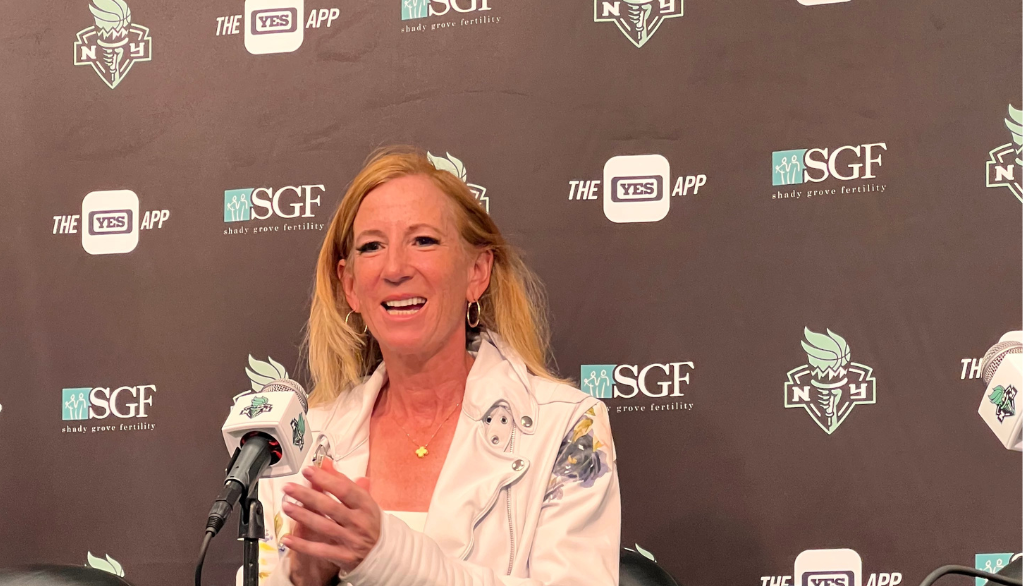by Aya Abdeen and Sara Jane Gamelli
The CBA negotiations between the WNBA and WNBPA continue to intensify as the current agreement’s Oct. 31 deadline quickly approaches.

Since Napheesa Collier called out WNBA Commissioner Cathy Engelbert on Sept. 30, tension among Engelbert, players, and owners has continued to grow. Not to mention, fans in Phoenix booed the Commissioner during the Las Vegas Aces’ Finals trophy presentation on Oct. 10.
WNBA and WNBPA “Extremely Unlikely” to Reach New CBA Agreement
On Tuesday, Ben Pickman of The Athletic reported that the WNBA and WNBPA are “extremely unlikely” to reach an agreement on a new CBA.
NEWS: The WNBA and the WNBPA are extremely unlikely to reach a new CBA by Friday’s deadline, according to the players’ union legal counsel.
— The Athletic (@TheAthletic) October 28, 2025
“In a dance, it takes two to tango. And it has been difficult to find a beat.”
More from @benpickman ⤵️https://t.co/cgQsv5yZSQ
WNBPA senior advisor and legal counsel Erin D. Drake appeared on The Athletic’s “No Offseason” podcast, released on Tuesday, and stated that no deal will be completed by Friday.
“We have worked hard to be able to say on Friday, we did it. Unfortunately, that’s not going to happen,” Drake said. “In a dance, it takes two to tango. And it has been difficult to find a beat, to find a rhythm and to find the same sense of urgency [from the league], just to be frank, to get this done.”
NBA Commissioner Adam Silver Weighs In on the WNBA CBA
All along, WNBA players and the WNBPA have repeatedly stated that they deserve higher, equitable pay that includes a fair and adequate revenue share. Currently, players receive nine percent of total revenue, compared to 50 percent for NBA players.
One week ago, NBA Commissioner Adam Silver addressed those concerns and the ongoing labor talks on NBC’s Today Show. While some viewed his comments negatively, Ballislife has the full context.
When asked by NBC anchor Craig Melvin whether WNBA players should receive a larger share of the league’s revenue, Silver confidently stated that players will receive a significant pay increase and answered “yes” when asked whether they should receive a larger share of the pie.
Yes. I mean, I think share isn’t the right way to look at it because there’s so much more revenue in the NBA,” said Silver. “I think you should look at absolute numbers in terms of what they’re making, and they are going to get a big increase in this cycle of collective bargaining, and they deserve it.
Throughout the 2025 season, players demanded better pay and rejected the league’s first proposal to the union. Phoenix Mercury forward Satou Sabally has been vocal about the WNBA’s issues, such as scheduling and player compensation.
Several players across the league travel overseas during the offseason for higher salaries. In recent years, they have the option to stay in the United States and play in leagues like Unrivaled and Athletes Unlimited.
“You know they know it’s bad when the best they say they can do is more of the same: a fixed salary system and a separate revenue-sharing plan that only includes a piece of a piece of the pie, and pays themselves (the league) back first,” WNBPA Executive Director Terri Carmichael Jackson said in a statement on Wednesday to The Athletic.
What’s Next: An Extension or a Work Stoppage?
Just a few hours later, Alexa Philippou of ESPN reported that the WNBA offered the WNBPA a 30-day extension to continue CBA negotiations and finalize a new deal.
Additionally, the players might consider an extension “under the right circumstances,” but a source says they believe “those circumstances do not yet exist.”
We have been negotiating with the Players Association in good faith and with urgency for several months with the goal of finalizing a new collective bargaining agreement as quickly as possible,” a WNBA spokesperson said, via ESPN. “Throughout this process, we have been clear that our top priority is reaching a new collective bargaining agreement that addresses players’ ask for significant increases in pay, benefits, and enhancements to their experience, while ensuring the long-term growth and success of the league and its teams.
“We urge the Players Association to spend less time disseminating public misinformation and more time joining us in constructive engagement across the table.”
The most recent CBA negotiations occurred in January 2020, following a 60-day extension granted during the 2019 negotiations.
As the Oct. 31 deadline for the WNBA and the WNBPA to reach a new CBA approaches, several questions remain unanswered. Most players will be unrestricted free agents in the upcoming free agency period, and the expansion drafts for both the Portland Fire and Toronto Tempo are still to be determined.
The CBA Goes Beyond Salaries, Addresses Scheduling and Season Structure
While pay and revenue share dominate CBA rhetoric, several other discussions are ongoing, including the schedule and the number of games in a season.
The league played a record 44 games in 2025, an increase of more than 22 percent from the 36 games played in 2022. According to the WNBA, the number of games played in a season is collectively bargained and reviewed by the players.
The average games per week was 2.58 in 2025, in line with other seasons. Here’s a breakdown of the WNBA’s average games per week since 2021:
- 2024 – 2.772 games per week (Olympic year)
- 2023 – 2.44 games per week
- 2022 – 2.68 games per week
- 2021 – 2.36 games per week
Although the WNBA season is much more condensed, we can compare these numbers to the NBA, which averaged 3.318 games per week across 82 games during the 2024-2025 season.
With a transformative CBA ahead, scheduling remains a difficult task, and the league continues to manage multiple priorities in the negotiations. Under Engelbert’s leadership, the WNBA has made several improvements, including player safety measures and charter flights in 2024. As league growth and progress continue, Engelbert has publicly stated her support for these negotiations.
“We continue to meet and have important conversations with the Players Association,” Engelbert said in October. “We want much of the same things that the players want. (We) want to significantly, and I mean significantly, increase their salary and benefits, while also supporting the long-term growth and viability of the WNBA.”
WNBA Faces Scheduling Challenges Amid Growth, Travel, and Major Sports Conflicts.
As a league that runs from May to October, the WNBA still faces many challenges. It’s not just about the number of games, but also about fitting the schedule around a wide variety of events.
For example, time zone changes, player travel accommodations, days of the week, and marquee matchups are just a few considerations when negotiating a schedule. With the league experiencing exponential growth, several highly anticipated matchups have been moved to arenas with larger capacities, which adds the challenge of securing arena availability.
On top of that, the league must avoid scheduling conflicts with other major professional sports. That includes the start of the NFL season, Major League Baseball, college football, and the NBA. In fact, Engelbert addressed this topic at length during the 2025 All-Star weekend in Indianapolis.
“There’s not much to do on the front end because of the college season, and the NCAA is such a big feeder of these amazing rookies, three of them now as All-Stars in our league,” said Engelbert in July. “You can do a little, but on the back end. How many college football Saturdays do you want to go into? How many NFL Sundays do you want to go into…That’s why data is really important to look at. What’s our fan base crossover with those other sports, and then the NBA would be starting. “
“Those are all things we’re looking at as we think about what’s the best footprint. What’s the best number of games?”
Pay, revenue share, and scheduling are just a few topics under collective bargaining. With an extension on the table, the players continue to push for improved benefits, prioritization, and working conditions, among several other issues. These are just some of the discussion points that both sides will negotiate, and it can’t bargained over night.
How A Work Stoppage Would Affect the WNBA
There are both pros and cons to the new CBA negotiations, as they could be transformative for the league. The WNBA has grown noticeably over the last few years, and that momentum is likely to continue, especially following the Caitlin Clark effect.
While Clark has moved the needle, the WNBA also has current and future stars like Paige Bueckers, JuJu Watkins, Hannah Hidalgo, Lauren Betts, Azzi Fudd, and Flau’Jae Johnson. With the league experiencing record-breaking growth in viewership, attendance, and merchandise, a work stoppage could halt that momentum and slow progress. The CBA negotiations come shortly after the league signed a $2.2 billion media rights deal.
A source said the players may be willing to consider an extension “under the right circumstances,” but they feel “those circumstances do not yet exist.” https://t.co/wghMS7t6kU
— Alexa Philippou (@alexaphilippou) October 28, 2025
Yes, the league has to guarantee that growth is sustainable from a business perspective; however, the players are demanding a fair revenue share and a bigger piece of the pie.
One could argue that a labor strike might hurt the league more than it would hurt the players. Set to tip off in January, Unrivaled offers players the opportunity to stay stateside during the offseason while earning salaries north of $200,000. While that benefits current players, Napheesa Collier told Glamour that surrendering would hinder the growth of women’s sports.
“If we give in, we’re not only doing a disservice to us, we’re doing a disservice to where we have gotten in women’s sports,” Collier told Glamour Magazine. “We really have no choice but to stand strong again, not just for the present, but for the future of our league too.”
